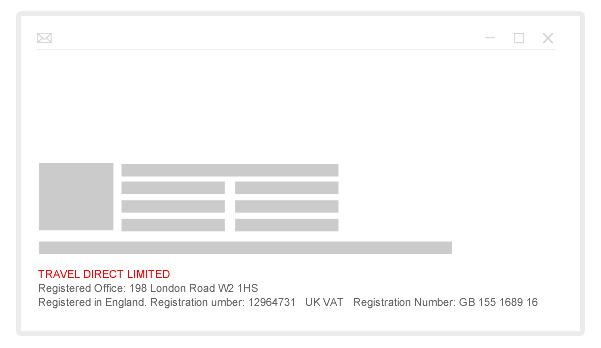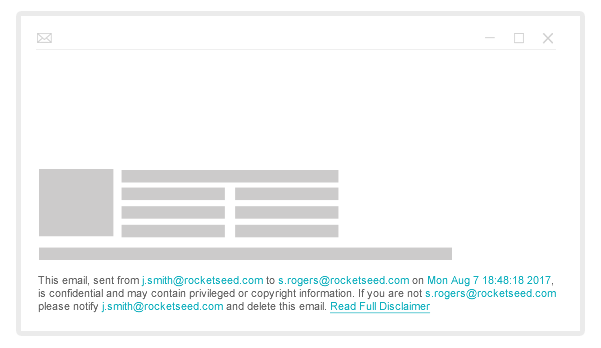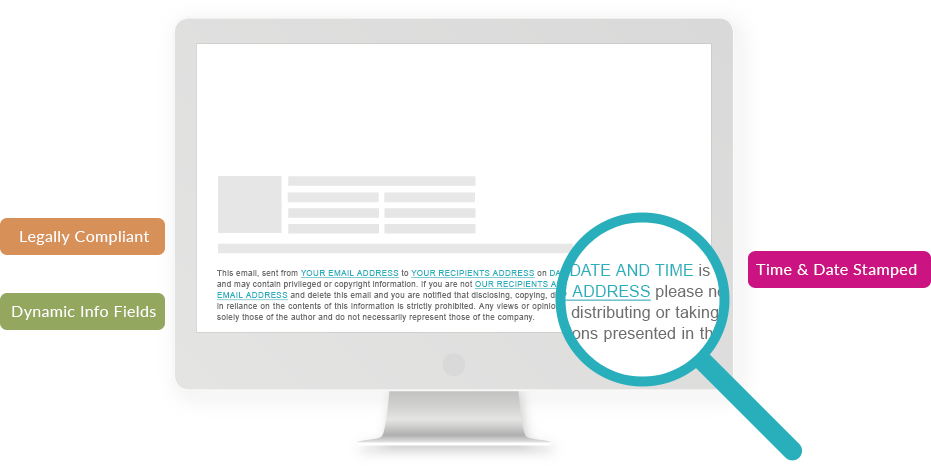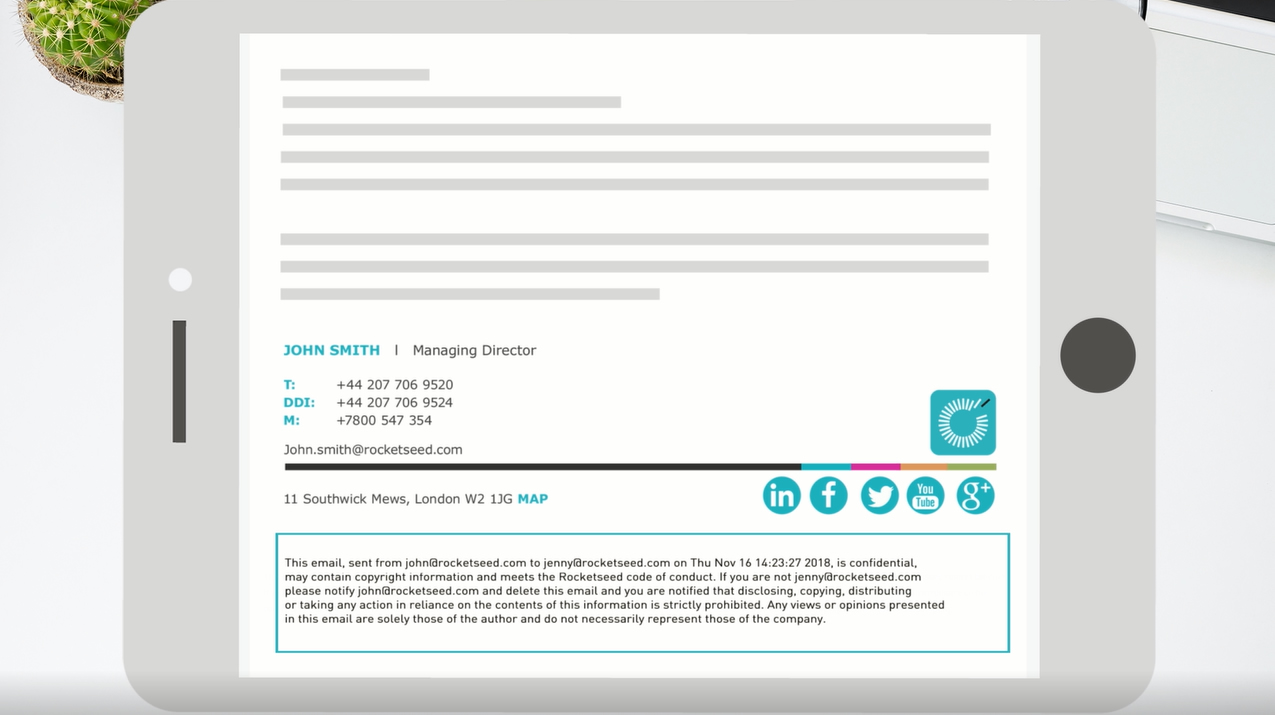Be compliant, covered and confident… add an email disclaimer
Can you afford to let your email leave your organisation open to legal action? Minimise this risk proactively and easily by adding a disclaimer statement to every email your organisation sends. From contracts and copyright to confidentiality and compliance, a simple disclaimer really is a ‘must have’ for your employee email.
Rocketseed specialise in creating and managing disclaimers for email as part of our email signatures offer.
Compliance now forms such an integral part of businesses large and small, it is key to make sure you protect yourself with an easy fix – an email disclaimer statement on every email.
So, if you have any concerns or questions about your current set up, let us know. Our experts have been working with clients developing the best bespoke email disclaimers for their organisations for years, so please contact us to discuss how we can help you.
How do I add and control email disclaimers?
Adding a disclaimer couldn’t be easier. With Parrot Digital, email disclaimers are added at the server level, making them tamper-proof and giving you central control, so you can manage them with the same flexibility as your email signatures and banners. Parrot Digital is compatible with all major email clients, including Office 365, Exchange and Gsuite.
Get an email signature that means business.
Here are the answers to some of most frequent email disclaimer questions we’re asked…
What are email disclaimers?
Email disclaimers are text statements added to emails (both external and internal) to disclaim liability, give legal protection and demonstrate regulatory compliance and email best practice.
The ultimate signature and disclaimer should look like this…
If you would like a free email disclaimer template, please continue reading.

Are email disclaimers necessary?
Yes, email disclaimers are necessary. Why? Because it’s the law in some countries (USA, Canada and the EU) and why wouldn’t you want to minimise the risks of legal action against your organisation?
Are email disclaimers legally binding?
Whilst the legal effectiveness of email disclaimers and whether they are legally binding or not is the subject of much debate, they may deter people from taking legal action against your organisation and from unlawfully forwarding confidential emails.
What does an email disclaimer need to include?
This depends on your organisation and where you’re operating. UK law states that all private and public registered limited companies and limited liability partnerships must legibly feature their company’s registered name, registration number, place of registration and registered office address. So, to avoid the risk of prosecution, make sure you keep your disclaimer up to date with the legal requirements for your business sector and location, and always seek legal advice.
Can an email disclaimer be dynamic?
With Rocketseed it is. A Rocketseed legal email disclaimer Office 365 or email disclaimer Gsuite can be dynamically personalised (i.e. not just static text) to include important information including sender and receiver email addresses and a time stamp of each message in real time, providing proof of intended recipients and date and time sent.
Email Disclaimer Examples
We’ve selected some sample email signature disclaimers to help you with both content and design.


Use our free email disclaimer template by copy and pasting the below text :
[Company Name] registered at [Registered Address], [Company Number]. This email, sent from [Sender Email Address] to [Recipient Email Address], is confidential and may contain privileged or copyright information. If you are not [Recipient Email Address] please delete this email and you are notified that disclosing, copying, distributing or taking any action in reliance on the contents of this information is strictly prohibited. This email is not a binding agreement and does not conclude an agreement without the express confirmation by the sender’s superior or a director of the Company. The Company does not consent to its employees sending non-solicited emails which contravene the law.
What issues can a disclaimer cover?
Confidentiality
Email disclosure is a key issue. Use your email disclaimer to warn a recipient that your email’s content is confidential, so if they breach this confidentiality, they could be liable.
If a confidential email is accidentally sent to an unintended unauthorised recipient then a disclaimer will bind them to confidentiality and can ask them to delete the email.
Employer’s Liability
A suitable email signature disclaimer can help decrease an organisation’s liability against offensive emails sent by an individual employee.
This is when it is important to have a clearly understood organisation-wide email policy, so a disclaimer can make clear that a policy exists and deter employees from breaching it.
Contracts
If you don’t wish any email content to be considered as forming a binding contract, this can be stated clearly in your email disclaimer, including that the sender is, in fact, not authorised to conclude contracts.
Regulatory Compliance
From professional codes of conduct to protecting client privacy, your email disclaimer can demonstrate that your organisation complies with the regulatory framework of the sectors and locations within which it operates.
Copyright
Copyright law may protect emails from being reproduced and a simple email disclaimer can reinforce this by stating that the rights to copy the email are reserved by the original author.
Viruses
You can also use a disclaimer to warn the recipient of the possibility, however unlikely, that the email may be infected by a virus, and advise them to conduct their own scan, thereby mitigating the risk that legal action will be taken against you for any infection.
Who in the organisation needs to use an email disclaimer?
Everyone. But that doesn’t mean that the same disclaimer will be best for everybody. Depending on the advice you receive, it is possible for each department has its own email disclaimer that suits its purposes best.
So, whilst your technical department might want to caveat its advice, your finance department might wish to emphasise confidentiality, whilst your sales team can use disclaimers to show the detailed terms of their quotes. The more tailored the disclaimer, the more notice will be taken of it.
Is there an ideal email disclaimer format?
There’s no ‘one-size-fits-all’ standard disclaimer, but if a simple email signature disclaimer can do the job, so much the better. You don’t want to scare off recipients with a 1,000 word disclaimer statement, so try and keep it to 5 lines or less. If you need to say more then add a link to a more detailed version online.
We can supply a sample of appropriate email disclaimer wording which, with Rocketseed, can feature dynamically personalised fields.

Does my organisation need an email policy?
Yes. So that every employee in your organisation uses email effectively and responsibly and understands the significance not only of the written content of their emails but also the correct use use of email signatures, banners and disclaimers.
Where’s the best place for an email disclaimer? Before or after the main message?
A disclaimer at the top will get noticed, but is likely to spoil your message and irritate the reader, so we recommend putting disclaimers below signatures at the end of the email.
By keeping your disclaimer separate from your email signature and banners, you can promote your brand without over-emphasising the ‘small print’.
Do I need a separate email confidentiality statement?
If the confidentiality statement is part of the disclaimer at the end of your email it might be too little too late if sent to an unintended recipient. So if you feel you need one, it makes sense to put it up-front, for example:
This message is private and confidential. If you have received this message in error, please notify us and remove it from your system.
Is there a best-practice email disclaimer?
The best email disclaimer Office 365 or email disclaimer Gsuite is simply one that gives your organisation the most protection, so make sure it’s tailored to your organisation and location, in accordance with legal advice, and is updated to meet appropriate email laws and enforced as part of your organisation’s email policy.
How do email disclaimers appear in an email chain?
Email disclaimers are applied to every email in a chain. Although the disclaimer typically appears in a distinct position beneath the email signature on the first email in the chain, it will typically sit at the very bottom of the email chain as the conversation progresses.
This way you are still legally compliant, but the disclaimer doesn’t visually impact on the email chain or detract from the content of successive emails.
Do I need a disclaimer on internal email too?
Yes. Not only to ensure issues such as internal email confidentiality but also to protect your organisation against the legal consequences of hostile or offensive emails circulating amongst employees. Best practice would be to include a link to your organisation’s email policy and tailor your internal disclaimer statements to specific departments if necessary.





